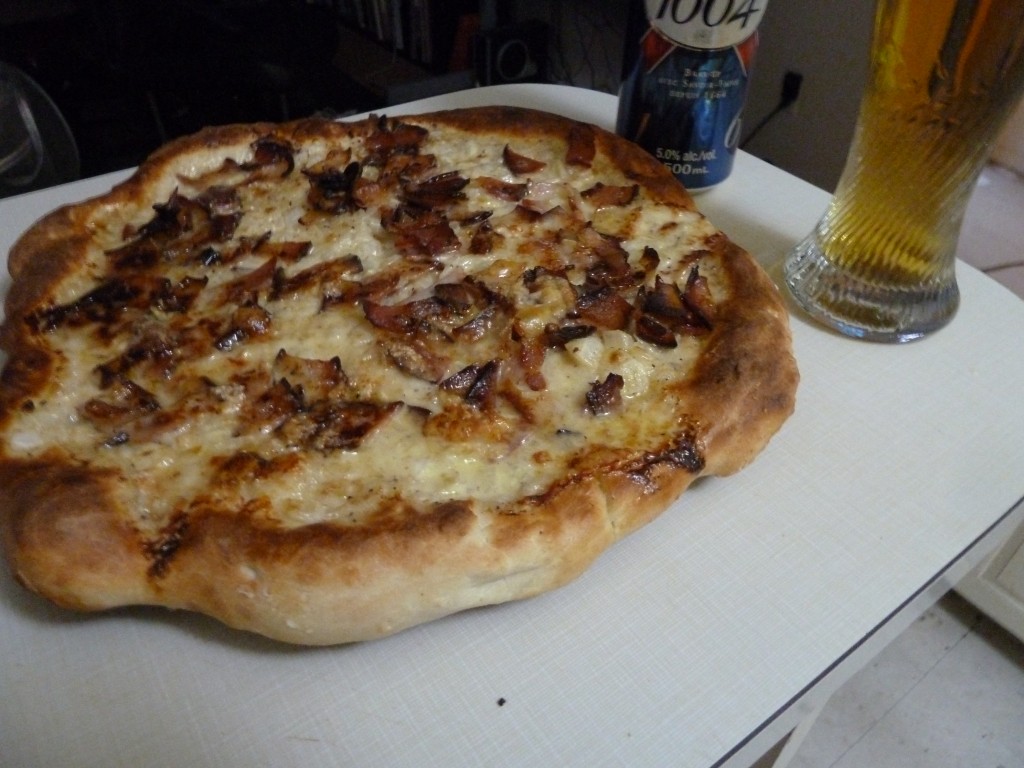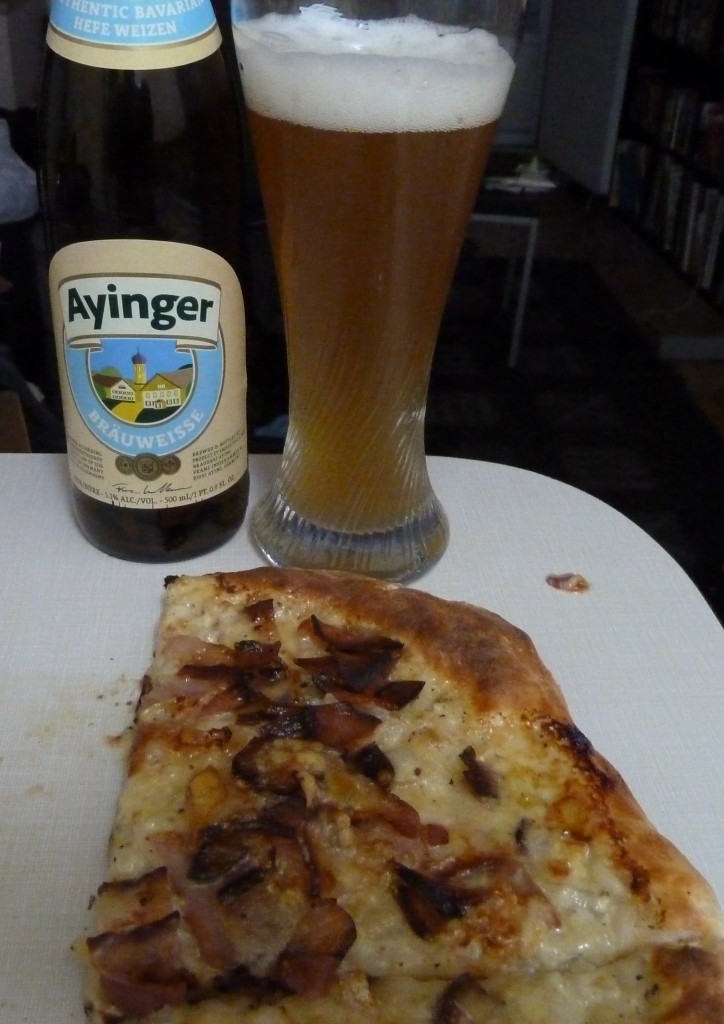As regular reader, Darren Siddorn, that long haired lover from Liverpool, pointed out last week on Beer and Food Tuesday, the dish that you’d expect to see associated with Strasbourg and Kronenbourg is Tarte Flambee or Flammekeuche.
It’s essentially an Alsatian flatbread dish that’s very close in makeup to being a pizza. The difference here is that instead of a tomato sauce or even a white sauce, crème fraiche is substituted into the mix. It makes sense that you would pair it with Kronenbourg because it’s probably what the people developing Kronenbourg would have been eating at the time. It’s a staple in Strasbourg, and the beer was developed in 1952. I theorize that the in post war period, this is the kind of dish that would have been popular because it doesn’t use much in the way of expensive or difficult to find ingredients. Onion, bacon, soured cream. Some nutmeg, if you have any.
My brain has been in and about the Rhine for much of the week, as I’ve been re-reading Patrick Leigh Fermor’s marvelous travel memoir A Time Of Gifts. It’s the account of his attempt to walk from Rotterdam to Constantinople in the early to mid 1930’s. Patrick Leigh Fermor may, incidentally, be the best beer writer that ever lived. His chronicle of traveling on foot through a changing Germany in the 1930’s includes what may be the best thing ever written about the Hofbrauhaus in Munich:
“I squeezed in at a table full of peasants, and was soon lifting one of those masskrugs to my lips. It was heavier than a brace of iron dumb-bells, but the blond beer inside was cool and marvelous, a brooding, cylindrical litre of Teutonic myth.”
What can I say? The man can write. Later that night, the combination of beer and schnapps cause some severe consternation, as you can well imagine. Pick the book up, if you get the chance.
The Beer:
While the dish is definitively Alsatian, I noticed while reading that the food being eaten throughout Germany on his travels is not so distinct even as the changes in dialect he encounters. For that reason, I’m allowing myself a certain amount of peregrination in terms of selecting beer.
It may be a mentality developed as a result of living in Ontario, which is just a massive province, but it seems to me that Strasbourg is close to Stuttgart and Bitburg and Munich. I am sure that all of these places have developed extremely distinct cultures. I am therefore limiting myself to a radius of around 200km. I take some solace in pointing out that Sophie’s Brauhaus in Stuttgart has Flammkuchen, and it’s pretty popular in Munich as well (to the extent that I can tell some of the discussion on the subject is a forum flame war about whose is the best without google translate).
For this reason, I’ve chosen Kronenbourg and Bitburger. I also got an Ayinger Brauweisse, which I have chosen on the basis that it looked so very lonely on the shelf, its brethren purloined.
The Recipe:
I’m easy. I went with this. I like it for this purpose because the recipe for the dough includes beer, meaning that I get a chance to experiment with how the flavour takes on. I’ve used Kronenbourg in the dough because I had some sample bottles left. It only calls for a quarter cup, but I feel like that’s probably going to have some influence. Possibly it will not be enough to make the other possible pairings work less well.
I’ve amended the recipe slightly to include some Munster on one side of the flammekeuche, which is apparently a pretty typical variant. I figure if you’re going to play around with flavours, go with the biggest, stinkiest cheese you can get.
Please do not send an Alsatian hit squad. I am joking.
I am including it because it is delicious, but also because I was at Alex Farm Products on Bayview and debated with the nice man in the frock about the merits of Munster or Gruyere. We decided on Munster because it’s that quintessential regional touch. It turns out that I’m not the first beer writer to come to him for advice. Beaumont used to do more or less the same thing. It’s kind of neat because it means that there’s an ongoing dialogue in taste in a larger community.
Beaumont’s been everywhere, man. Last I heard, he was in Mexico on the run from the Federales.
The Rundown:
Okay, look. This is pretty much beer food. It’s got bacon and onions and is more or less pizza, but with an earthy hint of nutmeg and a slightly sweeter crust and a hell of a lot more richness. It contains enough calories to make a handful of farmhands plow a dozen furrows. This ain’t everyday eating. For the love of god, this ain’t even monthly eating. Throw a couple beers on top of half of this thing and you’re taking the express line to foodcomaville, population: Tubby “Thunderchunks” McGee.
It is, however, exceptionally tasty.
Believe it or not, the Kronenbourg doesn’t seem to have an advantage here despite being used in the dough. The dough is not overwhelmingly sweet, but because of the crimping around the crust, it is the last thing that you taste. The first flavour is the smoke from the bacon and saltiness leading into the rich earthy onion and nutmeg, with a depth of flavour reinforced by the crème fraiche. The last thing you taste is the sweetness from the dough.

Kronenbourg was found wanting. I find that hard to explain. Possibly the recipe has changed since ’52. I see maize and hop extract on the can. This may have something to do with it.
The Kronenbourg is actually a little too malt heavy and the Strisselspalt hop is overpronounced, which will be the only time anyone ever writes that. It is also the case that you don’t get whatever peppery subtlety is in the tail.
I am glad that I went a little farther afield and got a Bitburger. First of all, it’s a Pilsner, which means that the additional hop bitterness is there to combat the sweetness of the dough. It’s not a perfect match because it contributes grass and a little bit of lemon on the nose. The higher carbonation is a vast improvement, providing some cleansing of the palate from the crème fraiche. It is not as sweet a beer, and that is the key issue there.
What about Munich, I hear you ask? How dare you forget plucky little Munich?
The Ayinger Brauweisse is maybe the best pairing here, despite the fact that it’s a completely unrelated style from over 200km away. It has carbonation enough to cleanse the palate and has an interesting side effect. The very slight clove notes seem to call out to the nutmeg in the recipe. The fruit and banana yeast character actually somehow reinforce the caramelized onion. It’s an example of two different sets of flavours coming together in an unexpected and pleasing way. Eine kleine difference, leibchen.
What Did We Learn:
1) Sometimes, when the damn recipe says “serves four” they mean “small families.”
2) Although tradition frequently dictates one set of flavours or pairings, food doesn’t care about 200 kliks. We have the internet to spread ideas. We have beer from all over. Let’s play.
3) Even though I don’t speak German, internet forum flame wars are pretty much the international language.
NEXT WEEK:
Something that don’t even include bacon.


Hmm, this looks go-o-od. It also looks like something that I can get away with in my breadmaker on the pizza dough cycle. Very appealing overall.
Brother, I gotta tell you. Breakfast tomorrow is going to be excellent.